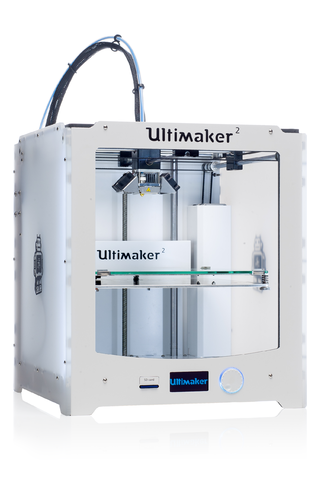
How does a 3D printer work? There are four different methods of 3D printing. Fused deposition modeling, stereolithography, digital light processing, and selective laser sintering.
3D printing is becoming more popular in the manufacturing process these days for many reasons, not least because it is additive manufacturing as opposed to subtractive manufacturing. When things are made in a factory on an industrial scale, they are usually cut out of a block, or formed in a mold. The manufacturing process is subtractive because it takes away from the original material and always leaves waste. 3D printing only prints where the object will be, so there is no waste.
The most common type of 3D printers are the fused deposition modeling (FDM) printers. When you imagine a 3D printer, you are probably thinking of one of these. They build an item by printing layers on top of layers. They are usually loaded with a thermoplastic, which is a plastic that becomes soft at a high temperature. A design is loaded into the printer, the thermoplastic is heated until it is soft, and the printer starts to put down layers of the plastic. As the plastic cools it hardens. You can usually tell if something has been made by FDM because there will be clear lines from each of the layers. FDM printing is fairly cheap, but it is very slow. It is slow because the process of melting the plastic and squeezing it through the nozzle is not very quick. A larger nozzle and a higher temperature will speed up the process, but then the finished product won’t be as good. FDM 3D printing was invented in 1989 by Scott Crump.
Stereolithography (SLA) is an older form of 3D printing than FDM, beating it by about 5 years. SLA was the first type of 3D printing. It works by using a laser to selectively cure a polymer resin in layers. An SLA machine has a bowl of resin with a laser underneath it. The baseplate of the printer is lowered into the resin and the laser starts to print the image. The resin is a photosensitive thermoset polymer and the laser is an ultraviolet light. When the UV light hits the resin, it sets. The printer draws the image on the resin with the laser and it sets hard. The baseplate then moves up one layer and the laser draws again. In this way, the whole object is printed in layers and slowly drawn out of the resin. SLA printing tends to be smoother than FDM printing and the objects are waterproof. The lines from the layers are less obvious. However, it prints layer by layer and it is still quite slow.
Digital light processing 3D printing is similar to SLA printing, but it is the next evolution. DLP also uses a bowl of photosensitive thermoset polymer, but the difference is in the light source used to make the resin harden. SLA uses a guided laser. DLP projects the whole image of the object at once onto the resin with a very strong light, printing a whole layer instantly. The projector and the baseplate are timed so that the projector projects the image and the baseplate pulls up, ready for the next layer. Printing is very fast and it looks like the objects are just being pulled out of the liquid. However, the finished objects can be brittle and they can be damaged by sunlight.
The fourth type of 3D printer is Selective Laser Sintering (SLS). SLS works by using a laser to fuse a powder together. The printer has a baseplate that sits in a bowl of powder. The powder can be any material, but plastic, metal, ceramics, and glass are common. The high-power laser fuses the powder together, layer by layer. The baseplate moves a layer, and the process is repeated. This process isn’t very fast, but the finished products are very strong. However, they are not waterproof because the powders are porous.
3D printing is becoming more and more popular. There are tremendous possibilities with it. There is less waste and things can be made to demand. The main problem with 3D printers is that the types of material that can be used are limited. Also, the finished products are not usually as strong as regular manufacturing methods. However, the technology is improving and this won’t be a problem for very long. 3D printing could be exceptionally useful in places where mass-production is not the goal, such as on the space station. It’s not possible to carry all the spare parts needed to the space station, but you could take material and a 3D printer. There is also the possibility that 3D printed organs could be a thing. Using stem cells, you could have an organ printed with your own cells, which would stop rejection during transplants. The future of 3D printers is looking rosy. And this is what I learned today.
Image By Guy Sie – https://www.flickr.com/photos/guysie/28127005370/, CC BY-SA 2.0, https://commons.wikimedia.org/w/index.php?curid=50259351
Sources
https://www.linkedin.com/advice/3/what-main-factors-affect-fdm-printing-speed-how-can
https://www.hubs.com/knowledge-base/what-is-fdm-3d-printing/
https://marketbusinessnews.com/incredible-potential-3d-printing/314796/
https://www.hubs.com/knowledge-base/what-is-sla-3d-printing/
https://en.wikipedia.org/wiki/Stereolithography
https://www.3dsystems.com/selective-laser-sintering
https://en.wikipedia.org/wiki/Selective_laser_sintering
https://www.cdwg.com/content/cdwg/en/articles/hardware/how-does-a-3d-printer-work.html
https://www.independent.co.uk/tech/what-is-3d-printing-b1821764.html
https://builtin.com/3d-printing
